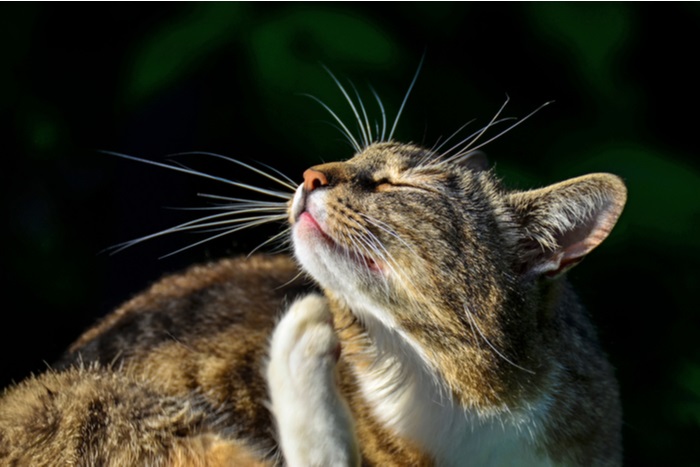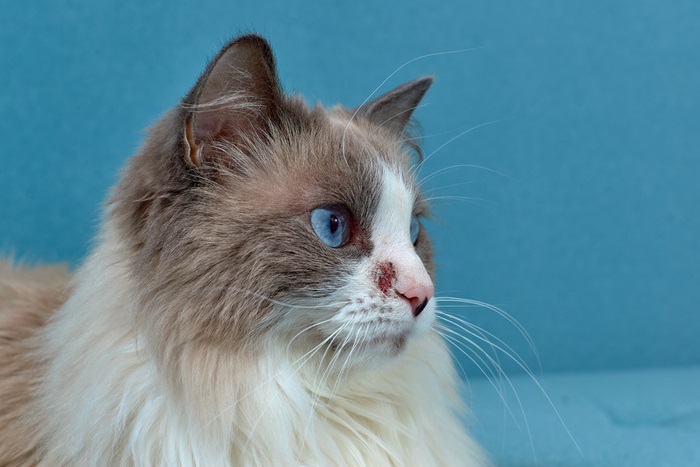
Do you have an itchy cat or a cat with poor coat? Have you wondered if your cat has allergies? Allergies in cats are a common cause of skin problems, but they can be frustrating to diagnose and treat.
What Are Allergies in Cats?
Allergies are an abnormal immune response to a harmless stimulus. When your cat’s body contacts an allergen through their skin or after breathing it in, a chain reaction starts that’s out of proportion to the danger your cat is in—a hypersensitivity reaction.
Immune system sentinel cells release cell signals that cause itching, swelling, and redness.
Cats are not usually born with allergies- they develop as your cat ages. Cats are usually diagnosed between six months and three years, but as diagnosis is often difficult, cats have been diagnosed as old as 14 years!
Most Common Cat Allergens
By far the most common allergy in cats is to flea saliva. This may be called ‘flea allergy’ or ‘flea allergic dermatitis’ (FAD). Flea allergies are thought to be the cause of around a third of skin problems in cats, and some cats are so sensitive they may react even if you haven’t seen a flea.
Cats can also have hypersensitivity reactions to mosquito and other insect bites, but this is less common than flea bite hypersensitivity.
The next most common allergy is environmental allergies.
In dogs, this is generally termed ‘atopy’ or ‘atopic dermatitis’, but in cats it’s usually called ‘non-food, non-flea hypersensitivity dermatitis’.
This is an allergen to things in the environment- pollen, cleaning products, weeds, trees, dust mites, dander, and cigarette smoke are all possible allergens your cat might have a hypersensitivity reaction to.
Food allergies make up about 1-5% of skin disease cases in cats.
Food allergies are built up over time- a cat can have eaten chicken-based food his whole life and still develop an allergy to chicken!
The most common food allergies in cats are beef, chicken and fish- all of which are common in feline diets.
Symptoms of Allergies in Cats

Allergic cats most often exhibit symptoms of skin irritation, showing scabbing, itchiness, and over-grooming.
Cats with allergies often have a skin reaction called ‘miliary dermatitis’. This causes hundreds of little rash-like, scabby lesions on your cat’s skin, especially along the back and neck.
They are also itchy- you may see them itching with their paws or grooming more often. Overgrooming their itchy skin can also lead to patches of hair loss. Some cats will be more prone to ear infections.
Cats that are allergic to airborne allergens such as pollen might also show allergy symptoms such as runny eyes, itchy eyes, sneezing, or even coughing and fast breathing.
Lastly, cats with allergies to their diet may have some gastrointestinal symptoms as well, such as loose stools, excessive gas, and occasional vomiting.
Diagnosis of Cat Allergies
Diagnosing cat allergies is theoretically simple, but it can take a long time. Since flea allergy is the most common allergy, the first thing to do is to rule out flea allergy as a cause of your cat’s symptoms.
This means applying prescription-strength flea treatment to every animal in the house for at least 12 weeks without any break in cover. This is necessary to ensure that the flea life-cycle is broken. If, with good flea control, your cat improves, a flea allergy will be presumed- but not diagnosed, as it could be a coincidence.
If your cat doesn’t improve despite flea control, the next rule-out is food. To diagnose a food allergy, a hypoallergenic exclusion diet must be fed.
This must either be a prescription hydrolysed diet or a novel protein diet. This diet needs to be fed exclusively for eight weeks to see whether your cat is going to respond- it’s usually necessary to shut them in for this time to ensure they aren’t eating at a neighbour’s house.
If your cat improves, food allergy is likely- feeding a bit of their old diet and watching for a return of the allergic symptoms is enough to be sure.
If food allergies have been ruled out, by definition your cat must be suffering from Non-Flea, Non-Food-Induced Hypersensitivity Dermatitis (NFNFIHD)- in other words, some sort of environmental allergy. Determining exactly what your cat is allergic to can be done with blood tests or skin tests using subcutaneous injections to test for a response.
In some cases, referral to a veterinary dermatologist may be necessary, especially if your clinic doesn’t have the appropriate equipment for skin tests, or if your cat’s case is difficult.
Treatment for Allergies in Cats

Treatment of allergies in cats varies depending on the types of allergens your cat is sensitive to.
Treating allergies in cats usually involves a combination of approaches. Allergen avoidance involves reducing your cat’s exposure to any offending allergens- try keeping your cat indoors with the windows closed on high-pollen days, ensure the house is clear of mildew, and use hypoallergenic bedding. Using cat litters that are dust-free can also help.
A change in diet can help cats, even if they aren’t allergic to their food. Feeding a diet with lots of fatty acids may help to prevent allergens from working their way under the skin and causing problems.
For all allergic cats, flea treatment is essential. Even if your cat’s allergy isn’t to fleas, the extra itch caused by a flea infestation can set them off with a flare-up. Talk to your vet about prescription flea treatment.
Lastly, drugs that prevent immune over-reaction may be necessary. These can include corticosteroids, antihistamines, and cyclosporine, among other things. These can be given by injection (allergy shots) or with tablets at home.
Conclusion
Feline allergies are a common cause of skin disease in cats, but most can be cured with effective flea treatment. For those that can’t, proper diagnosis and treatment with the vet should help to reduce your cat’s symptoms.







